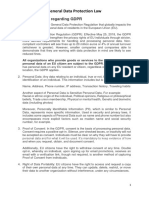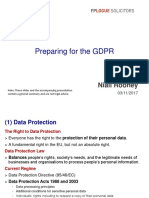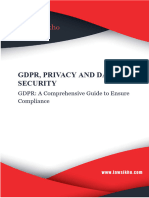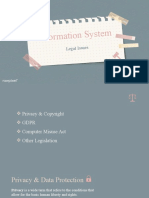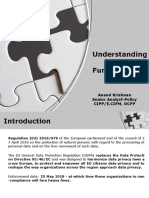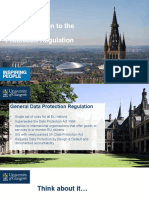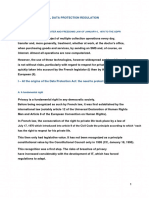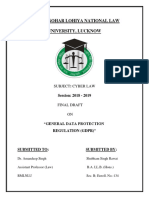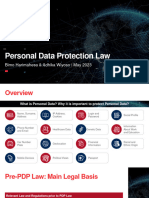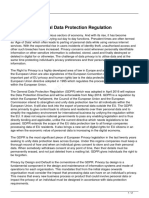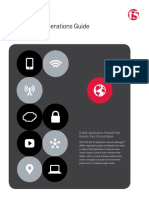Version Last Updated: July 2019
1
� Version Last Updated: July 2019
DATA PROTECTION BASICS
Data protection law covers most situations in which information about somebody (the
‘personal data’ of a ‘data subject’) is used in some way (‘processed’) by some other
person or organisation (the ‘controller’), other than in a purely personal context.
The Data Protection Commission (DPC) is responsible for regulating different sets of
laws, which cover different ways and circumstances in which personal data might be
processed. These laws are set out below and on the DPC’s website.
The ‘General Data Protection Regulation‘ (GDPR) is the law which applies to most kinds
of processing of personal data and it applies directly in Ireland (and across the EU),
along with further national rules set out in the Irish Data Protection Act 2018.
However, the GDPR does not apply to the processing of personal data by an individual
for ‘purely personal or household’ activities, with no connection to a professional or
commercial activity. This is sometimes known as the ‘personal/household/domestic
exemption’. This might cover activities such as correspondence, keeping an address
book, or certain social networking, where these activities are purely personal. The
GDPR would still apply to controllers who process personal data to facilitate these
activities (such as a social network).
Where processing takes place for law enforcement purposes (such as preventing or
detecting crime) the GDPR does not apply, and instead the ‘Law Enforcement Directive’
(LED) covers these situations, the rules for which are found mainly in Part 5 of the
Data Protection Act 2018 (which implements the LED into Irish law).
Ireland’s ‘ePrivacy Regulations’ (S.I. 336/2011, which implemented the EU ‘ePrivacy
Directive’) are an extra set of rules which apply to certain types of processing, including
electronic direct marketing and cookies, and these rules apply in addition to the
rules found in the Data Protection Act 2018 and the GDPR.
These laws set out various obligations on data controllers and rights for data subjects,
some of which are discussed below. They also set out the powers and responsibilities
of the DPC. If you have a concern that a controller has failed to follow the law or uphold
your rights, the guidance below should help you (a) make a request to a controller,
or (b) make a complaint to the DPC, if they fail to comply with your request or their
obligations under data protection law.
2
� Version Last Updated: July 2019
Personal data basically means any information about a living person, where that
person either is identified or could be identified. Personal data can cover various
types of information, such as name, date of birth, email address, phone number,
address, physical characteristics, or location data – once it is clear to whom that
information relates, or it is reasonably possible to find out.
Personal data doesn’t have to be in written form, it can also be information about
what a data subject looks or sounds like, for example photos or audio or video
recordings, but data protection law only applies where that information is processed
by ‘automated means’ (such as electronically) or as part of some other sort of filing
system.
Personal data can be information where the data subject is identified – “John’s
favourite colour is blue” – or where they are ‘identifiable’ – “John’s sister’s favourite
colour is blue” (where you don’t know his sister’s identity, but could find out using
context and/or additional information).
Even where personal information is partially anonymised, or ‘pseudonymised’, but
this could be reversed and the data subject could possibly be identified using
additional information, it should still be considered personal data. However, if
information is truly anonymised, irreversibly, and could not be traced back to an
identified person, it is not considered personal data.
To determine whether a person is ‘identifiable’, particularly where the information
about that person is pseudonymised, all the methods and information reasonably
likely to be used by the controller or other person to identify someone, either
directly or indirectly, have to be considered.
Certain types of sensitive personal data, called ‘special categories’, are subject to
additional protection under the GDPR, and their processing is generally prohibited,
except for where specific requirements are met (such as having explicit consent), as
set out in detail in Article 9 GDPR. The special categories are: personal data revealing
racial or ethnic origin, political opinions, religious or philosophical beliefs, or trade
union membership; genetic data; biometric data processed to uniquely identify a
person; data concerning health; and data concerning a person’s sex life or sexual
orientation.
Data protection law governs situations where personal data are ‘processed’.
Processing basically means using personal data in any way, including; collecting,
storing, retrieving, consulting, disclosing or sharing with someone else, erasing, or
destroying personal data. Although, as mentioned above, data protection law does
not apply where this is done for purely personal or household activities.
3
� Version Last Updated: July 2019
A ‘controller’ refers to a person, company, or other body that decides how and why
a data subject’s personal data are processed. If two or more persons or entities decide
how and why personal data are processed, they may be ‘joint controllers’, and they
would both share responsibility for the data processing obligations.
A ‘processor’ refers to a person, company, or other body which processes personal
data on behalf of a controller. They don’t decide how or why processing takes place,
but instead carry out processing on the orders of a controller.
As mentioned above, if a person (but not a company or other body) decides how and
why personal data are processed, and/or processes that data, but they only do so in
a purely personal or household capacity, they will not be subject to the obligations
of controllers under the GDPR or Data Protection Act 2018.
Regarding processing for the purposes of law enforcement, the specific rules in the
LED and Part 5 of the Data Protection Act only apply to processing where the
controller is a ‘competent authority’. This is defined as a public authority which is
‘competent’ for law enforcement purposes (such as the Gardaí or the Revenue
Commissioners), or any other body which is authorised by law to exercise public
authority and powers for law enforcement purposes.
Controllers have a range of obligations under data protection law, and in particular
must comply with the principles of data protection, as found in Article 5 GDPR,
ensuring personal data are: processed lawfully, fairly and transparently; processed
for specific purposes; limited to what is necessary; kept accurate and up to date;
stored for no longer than necessary; and protected against unauthorised or unlawful
processing, accidental loss, destruction, or damage. Controllers must also be able to
demonstrate compliance with these principles, under the principle of accountability.
Under the principle of transparency, controllers should provide certain
information to data subjects when they collect their personal data, such as: the
identity of the controller; the contact details of the controller and (if they have one)
their ‘data protection officer’ (DPO); the purposes and ‘legal basis’ for the processing;
who the data will be shared with; how long the data will be stored; and the existence
of the data subject’s various rights.
If you want to exercise any of your rights as a data subject, the first step is to identify
who the data controller is, and then to make your data subject request to them
(more information on data subject rights and requests can be found below). If they
don’t respond or don’t allow you to exercise your rights, or if you think there has been
any other infringement of data protection law, you can contact the DPC.
4
� Version Last Updated: July 2019
In data protection terms a ‘legal basis’ (also referred to as a ‘lawful basis’ or ‘lawful
reason’) means the legal justification for the processing of personal data. A valid
legal basis is required in all cases if a data subject’s personal data are to be lawfully
processed in line with data protection law.
Under the GDPR, there are six possible legal bases for processing personal data,
found in Article 6, namely: consent; contractual necessity; compliance with a legal
obligation; protecting vital interests; performance of an official or public task; and
legitimate interests (where the interest is not outweighed by the data subject’s).
There is no hierarchy or preferred option within this list, but instead all processing
of personal data should be based on the legal basis which is most appropriate in
the specific circumstances of that processing. Controllers should be aware that there
may be different legal bases applicable to different types of processing of the same
personal data.
It is important to note that ‘consent’, whilst perhaps the most well-known, is not the
only legal basis for processing personal data – or even the most appropriate in
many cases. Where consent is used, there are a number of special requirements for
it to provide a valid legal basis for processing; it has to be specific, informed, and
unambiguous, and it has to be freely given. It must always be possible to withdraw
consent after it has been granted; once it is withdrawn, the personal data cannot be
processed any further on the basis of consent.
As mentioned above, under the GDPR, certain special categories of personal data
should not be processed except in limited circumstances. Such processing requires
both a legal basis under Article 6 GDPR, as well as meeting one of the exceptions in
Article 9 (such as explicit consent or protection of vital interests) which allow such data
to be processed.
It is the responsibility of every controller to identify which legal basis they are
relying on for each type of processing of personal data they engage in. This
information should be provided to data subjects, as part of the principle of
transparency, and controllers should always be able to identify the legal basis they
are relying on for processing if asked by a data subject or the DPC.
For controllers processing personal data for law enforcement purposes under the
LED, the justification for such processing must either be that they have the consent
of the data subject or that the processing is necessary for the performance of their
functions for the purpose of ‘the prevention, investigation, detection or prosecution
of criminal offences, including the safeguarding against, and the prevention of, threats
to public security’, or ‘the execution of criminal penalties’.
5
� Version Last Updated: July 2019
Individuals have a number of specific rights under data protection law to keep them
informed and in control of the processing of their personal data. The most commonly
exercised of those rights are those found under the GDPR (in Articles 12-22 and 34).
The data subject rights under the GDPR include: the right to be informed if, how,
and why your data are being processed; the right to access and get a copy of your
data; the right to have your data corrected or supplemented if it is inaccurate or
incomplete; the right to have your data deleted or erased; the right to limit or restrict
how your data are used; the right to data portability; the right to object to processing
of your data; and the right not to be subject to automated decisions without human
involvement, where it would significantly affect you.
Information provided to data subjects when these rights are exercised must be
transparent, understandable and easily accessible, using clear and plain
language. The information should be provided in writing, or other means, including,
where appropriate, electronically. When requested by the data subject, the
information may be provided orally, provided that the identity of the data subject is
clear or can be proven.
It is important to note that these rights are not absolute, and are subject to a
number of limitations and restrictions. Certain rights apply to all processing
activities, such as the right to information or to access to personal data, whereas other
rights only apply in certain circumstances, such as the rights to erasure, restriction,
portability, and objection. Both the GDPR and the Data Protection Act 2018 set out
limitations and restrictions on these rights.
Where personal data are processed for law enforcement purposed under the LED,
data subjects have similar rights, found in Sections 89-95 of the Data Protection Act
2018, which are subject to a range of restrictions. These rights include the right to
information, right of access, and rights to rectification, erasure, and restriction.
To exercise any of these data protection rights, data subjects should first make a data
subject request to the data controller. If the controller does not respond or does
not allow a data subject to exercise their rights, data subjects may then wish to contact
the DPC to make a complaint.
More information on the various data subject rights, their extent and limitations, and
how to exercise them, can be found on the guidance for individuals on the DPC’s
website.
6
� Version Last Updated: July 2019
Electronic direct marketing involves the sending or making of unsolicited marketing
communications, including by email, text message, phone or fax, to a recipient.
These communications are usually made for the purpose of advertising a product or
service or for other promotional purposes. Electronic direct marketing of this kind is
subject to specific rules that are set out in the ePrivacy Regulations (S.I. 336/2011).
Under the ePrivacy Regulations, the organisation or person on whose behalf direct
marketing communications are sent must generally have obtained the prior consent
of the intended recipient, agreeing to receive such communications – and they must
be able to demonstrate that the recipient actively agreed in advance to receiving
such communications. Consent must be a clear, affirmative act, freely given, specific,
informed, and unambiguous, as required by the GDPR (these two laws work together
in such cases). Where consent to marketing is given, it can be withdrawn at any time.
The GDPR notes that silence, pre-ticked boxes, or inactivity will not generally be
enough to signify consent. This means that a direct marketer cannot normally, for
example, rely on the recipient failing to untick a pre-ticked box as a valid form of
consent. Each direct marketing message sent by email or text should also identify
the sender, or on whose behalf it is being sent, and provide a valid address so that
the recipient may request that the sending of such messages should cease.
There are certain limited exceptions where electronic direct marketing
communications can be sent without obtaining the prior consent of the recipient. For
example, controllers may send electronic direct marketing messages to their
customers without explicitly having consent, but only if; they collected the contact
details during the sale of a product or service; they’re marketing their own product or
service; it is a similar product or service to the original sale; the first marketing
message was sent within 12 months of the original sale; and, most importantly, the
data subject was given a chance to object to receiving marketing messages, both at
the time of the original sale and with each subsequent marketing message.
Under the GDPR (Article 21), individuals also have the right to object at any time to
their personal data being used for direct marketing purposes. This includes not just
electronic direct marketing but also postal and other forms of direct marketing. If
such an objection is made, then the organisation must cease using their personal
data for direct marketing; this includes deleting it from any marketing databases.
More detailed information can be found on the DPC website on electronic direct
marketing, including guidance the DPC has published on the national directory
database (NDD) and the issuance of e-receipts.
7
� Version Last Updated: July 2019
A cookie is a small text file that can be placed and stored on a user’s computer or
device by a website the user has visited, and can serve a number of purposes. These
include enabling the website to recognise the user the next time the user visits it and
to ‘remember’ the user’s actions or preferences over a period of time, or the cookie
may contain data related to the function or delivery of the website.
Cookies can be set by the owner of the website or, in some cases, by third party
services. In such a case, the website owner allows the third party to present other
information, run content or advertisements, or provide other functionality such as
analytics, through its website.
The website owner, or third party services, must normally obtain consent from users
to place and use cookies and other similar technologies on a user’s computer or
device, as required by the ePrivacy Regulations (S.I. 336/2011). However, the user’s
consent is not required where the cookie or other technology is strictly necessary
to provide the user with the service they have requested – for example, cookies
which may be needed to run certain essential functions on a website.
The website owner must also provide users with certain easily accessible, clear, and
comprehensive information on the type of cookies or similar technology they are
using and the purpose for which they are using it.
Further guidance on the use of cookies and other similar technologies can be found
on the DPC website.




